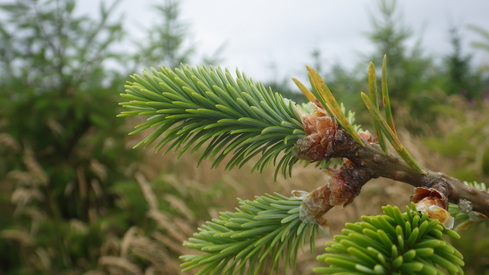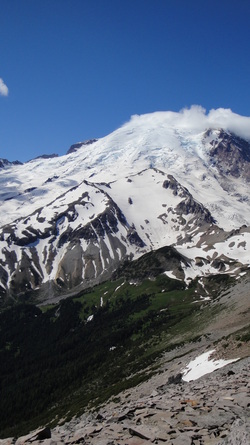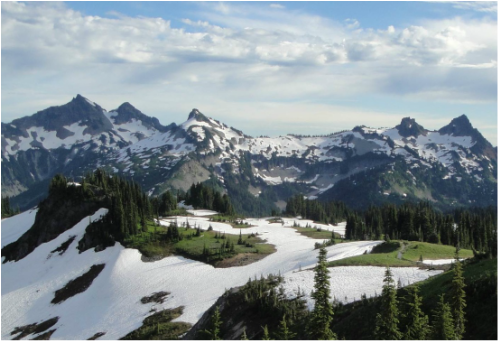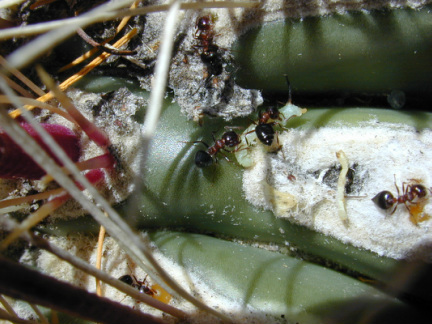Research
 Photo credit: Teresa Vail
Photo credit: Teresa Vail
Will changes in tree phenology track climate change?
The ability of organisms to match their phenology to the timing of seasonal changes in climate strongly influences a number of important biological processes, such as individual fitness, species range shifts, interspecific interactions and ecosystem function. Thus, the resilience of species and ecosystems to climate change will depend on the capacity of organisms to shift their phenology to track changes in climate. In temperate forests, trees will need to initiate growth earlier in the spring and cease growth growth later in the autumn to match their growth periods with favorable growing conditions. But how well trees will be able to track these changes remains an open question due to constraints imposed by chilling requirements, photoperiod cues and patterns in genetic variation. To help address this issue, I am examining how climate change will affect the phenology of coast Douglas-fir across its geographic range, how these phenological responses might impact the tree’s resilience to climate change and how genetic differences could mediate these impacts. To do this, I am combining extensive phenological data with novel modeling approaches and high-resolution climate change projections. Coast Douglas-fir is a foundation species in Pacific Northwest forests, so its response to climate change will have enormous consequences for ecosystems across the region.
A paper in Global Change Biology describing some of these results can be found here.
The ability of organisms to match their phenology to the timing of seasonal changes in climate strongly influences a number of important biological processes, such as individual fitness, species range shifts, interspecific interactions and ecosystem function. Thus, the resilience of species and ecosystems to climate change will depend on the capacity of organisms to shift their phenology to track changes in climate. In temperate forests, trees will need to initiate growth earlier in the spring and cease growth growth later in the autumn to match their growth periods with favorable growing conditions. But how well trees will be able to track these changes remains an open question due to constraints imposed by chilling requirements, photoperiod cues and patterns in genetic variation. To help address this issue, I am examining how climate change will affect the phenology of coast Douglas-fir across its geographic range, how these phenological responses might impact the tree’s resilience to climate change and how genetic differences could mediate these impacts. To do this, I am combining extensive phenological data with novel modeling approaches and high-resolution climate change projections. Coast Douglas-fir is a foundation species in Pacific Northwest forests, so its response to climate change will have enormous consequences for ecosystems across the region.
A paper in Global Change Biology describing some of these results can be found here.

The interactive effects of climate and soil on plant species range shifts
How does climate affect the distribution of species? Answering this classic question is critical for protecting biodiversity in the face of climate change. Warming is expected to result in range shifts along climatic gradients (e.g., shifts to higher latitudes or elevations). However, it is typically a combination of climatic and non-climatic constraints that sets the range limits of species, and both will likely play important roles in species responses to climate change. The goal of this research is to improve our understanding of these issues by studying the responses of plant species to differences in climate and the effect of an important non-climatic factor (soil) on these responses. The research was done in the high elevation habitats of Mount Rainier National Park. With increasing elevation, closed-canopy forests give way to subalpine and alpine meadows, which give way to bare ground and ice. Warming is predicted to result in an upward movement of species in these locations. However, limits on plant establishment in new habitat could differentially constrain species range shifts. Specifically, trees may invade meadows faster than meadow species shift upwards because poor soils above the meadows may limit establishment. If this occurs, the ranges of meadow species may contract at their lower limit due to tree encroachment faster than they expand at their upper limit by colonizing bare ground, resulting in a reduced range. These range reductions would pose a serious threat to these species that already occupy small and fragmented habitats. To help test these hypotheses, I have conducted a seedling transplant experiment in which I exposed seedlings of tree, subalpine meadow and alpine meadow species to different combinations of climate and soil conditions to determine their joint influence on plant establishment and the consequences for species responses to climate change.
You can see a write-up and video of a talk I gave on this research at the Northwest Climate Science Conference here.
How does climate affect the distribution of species? Answering this classic question is critical for protecting biodiversity in the face of climate change. Warming is expected to result in range shifts along climatic gradients (e.g., shifts to higher latitudes or elevations). However, it is typically a combination of climatic and non-climatic constraints that sets the range limits of species, and both will likely play important roles in species responses to climate change. The goal of this research is to improve our understanding of these issues by studying the responses of plant species to differences in climate and the effect of an important non-climatic factor (soil) on these responses. The research was done in the high elevation habitats of Mount Rainier National Park. With increasing elevation, closed-canopy forests give way to subalpine and alpine meadows, which give way to bare ground and ice. Warming is predicted to result in an upward movement of species in these locations. However, limits on plant establishment in new habitat could differentially constrain species range shifts. Specifically, trees may invade meadows faster than meadow species shift upwards because poor soils above the meadows may limit establishment. If this occurs, the ranges of meadow species may contract at their lower limit due to tree encroachment faster than they expand at their upper limit by colonizing bare ground, resulting in a reduced range. These range reductions would pose a serious threat to these species that already occupy small and fragmented habitats. To help test these hypotheses, I have conducted a seedling transplant experiment in which I exposed seedlings of tree, subalpine meadow and alpine meadow species to different combinations of climate and soil conditions to determine their joint influence on plant establishment and the consequences for species responses to climate change.
You can see a write-up and video of a talk I gave on this research at the Northwest Climate Science Conference here.
 Photo credit: Elli J. Theobald
Photo credit: Elli J. Theobald
The joint effects of climate and competition on tree growth
Tree growth strongly influences the population dynamics of tree species and the functioning of forest ecosystems. To anticipate how forests will respond to climate change, it is therefore critical to understand how climate influences tree growth. Trees can differ greatly in their responses to climate based on their local competitive environment (the density of neighboring trees, i.e., forest stand structure), making it important to understand how climate-growth relationships vary with different levels of competition. Collaborators and I have addressed these issues using a large and long-term forest demography dataset, with 7,808 individuals tracked from 1976-2008 in fifteen 1 ha plots in mature and old-growth forests at Mount Rainier National Park. The study covered a large climatic gradient (plots spanned 900 m of elevation and 4°C of mean annual temperature) with a variety of competitive environments (local basal area density values of 6 to 313 square meters per hectare) for a range of tree sizes (5 to 247 cm diameter at breast height). We used a hierarchical Bayesian modeling approach to characterize the joint effects of climate, competition and tree size on individual growth to develop more nuanced and realistic projections of climate change impacts on tree growth at both individual and stand scales. We found that forest stand density and the intensity of competition drastically alter how tree growth responds to differences in climate.
A paper on this research in the Canadian Journal of Forest Research can be found here.
Tree growth strongly influences the population dynamics of tree species and the functioning of forest ecosystems. To anticipate how forests will respond to climate change, it is therefore critical to understand how climate influences tree growth. Trees can differ greatly in their responses to climate based on their local competitive environment (the density of neighboring trees, i.e., forest stand structure), making it important to understand how climate-growth relationships vary with different levels of competition. Collaborators and I have addressed these issues using a large and long-term forest demography dataset, with 7,808 individuals tracked from 1976-2008 in fifteen 1 ha plots in mature and old-growth forests at Mount Rainier National Park. The study covered a large climatic gradient (plots spanned 900 m of elevation and 4°C of mean annual temperature) with a variety of competitive environments (local basal area density values of 6 to 313 square meters per hectare) for a range of tree sizes (5 to 247 cm diameter at breast height). We used a hierarchical Bayesian modeling approach to characterize the joint effects of climate, competition and tree size on individual growth to develop more nuanced and realistic projections of climate change impacts on tree growth at both individual and stand scales. We found that forest stand density and the intensity of competition drastically alter how tree growth responds to differences in climate.
A paper on this research in the Canadian Journal of Forest Research can be found here.

Spatial patterns in ecologically important climate variables at coarse and fine scales
With rapid climate change expected in the coming decades, ecologists have predicted that species ranges will shift large distances in elevation and latitude. However, most range shift assessments are based on coarse-scale climate models that ignore fine-scale heterogeneity and could fail to capture important range shift dynamics. Moreover, if climate varies dramatically over short distances, some species may only need to migrate tens of meters between microhabitats to track their climate as opposed to hundreds of meters upward or hundreds of kilometers poleward. To address these issues, we measured climate variables that are important determinants of plant species distributions (snow disappearance date and soil temperature) at coarse and fine scales at Mount Rainier National Park. Collaborators and I found that fine-scale differences in climate by topographic position and vegetation structure were often large relative to coarse-scale differences across elevation. These strong patterns in microclimate will likely complicate range shift dynamics and could buffer species from some of the negative impacts of climate change.
A paper on this research in PLoS ONE can be found here.
With rapid climate change expected in the coming decades, ecologists have predicted that species ranges will shift large distances in elevation and latitude. However, most range shift assessments are based on coarse-scale climate models that ignore fine-scale heterogeneity and could fail to capture important range shift dynamics. Moreover, if climate varies dramatically over short distances, some species may only need to migrate tens of meters between microhabitats to track their climate as opposed to hundreds of meters upward or hundreds of kilometers poleward. To address these issues, we measured climate variables that are important determinants of plant species distributions (snow disappearance date and soil temperature) at coarse and fine scales at Mount Rainier National Park. Collaborators and I found that fine-scale differences in climate by topographic position and vegetation structure were often large relative to coarse-scale differences across elevation. These strong patterns in microclimate will likely complicate range shift dynamics and could buffer species from some of the negative impacts of climate change.
A paper on this research in PLoS ONE can be found here.
 Photo credit: Will Wilson
Photo credit: Will Wilson
The demographic consequences of mutualism
Mutualisms can strongly influence the distribution and abundance of species and shape ecological communities. But the impacts of mutualists on partner population dynamics are complex and poorly understood. Mutualists can have differing effects on partner vital rates, benefiting certain vital rates while having neutral or negative impacts on others. In turn, these vital rates differ in their importance for population growth. To appropriately gauge the impact of mutualists on their partner's population dynamics, ecologists must integrate mutualist effects on multiple vital rates and the influence of those vital rates on population growth. Unfortunately, this approach has generally not been used in mutualism studies because it requires intensive data collection and analysis. I have taken on these issues by studying the demography of the cactus Ferocactus wislizeni in the context of its interaction with a guild of ant species. The plant produces extrafloral nectaries (modified spines that exude nectar) which attract several species of ants that feed at the nectaries. While at the nectaries, ants are likely to attack herbivores attempting to consume reproductive buds, flowers or fruits. We used maximum likelihood methods to model the effects of ants on all key plant vital rates (fruit production, individual growth and survival) and integral projection models to assess the net effect of ants on population growth. The models also allowed us to evaluate how these effects differ by ant species. In addition, we used simulation experiments to explore how rare but potentially important events (insect herbivore outbreaks or years with exceptionally high recruitment associated with abundant precipitation) might alter the long-term effect of ants on plant populations. This analysis yielded insight into the demographic complexities of a seemingly clear example of mutualism.
A paper on this research in Oecologia can be found here.
Mutualisms can strongly influence the distribution and abundance of species and shape ecological communities. But the impacts of mutualists on partner population dynamics are complex and poorly understood. Mutualists can have differing effects on partner vital rates, benefiting certain vital rates while having neutral or negative impacts on others. In turn, these vital rates differ in their importance for population growth. To appropriately gauge the impact of mutualists on their partner's population dynamics, ecologists must integrate mutualist effects on multiple vital rates and the influence of those vital rates on population growth. Unfortunately, this approach has generally not been used in mutualism studies because it requires intensive data collection and analysis. I have taken on these issues by studying the demography of the cactus Ferocactus wislizeni in the context of its interaction with a guild of ant species. The plant produces extrafloral nectaries (modified spines that exude nectar) which attract several species of ants that feed at the nectaries. While at the nectaries, ants are likely to attack herbivores attempting to consume reproductive buds, flowers or fruits. We used maximum likelihood methods to model the effects of ants on all key plant vital rates (fruit production, individual growth and survival) and integral projection models to assess the net effect of ants on population growth. The models also allowed us to evaluate how these effects differ by ant species. In addition, we used simulation experiments to explore how rare but potentially important events (insect herbivore outbreaks or years with exceptionally high recruitment associated with abundant precipitation) might alter the long-term effect of ants on plant populations. This analysis yielded insight into the demographic complexities of a seemingly clear example of mutualism.
A paper on this research in Oecologia can be found here.

